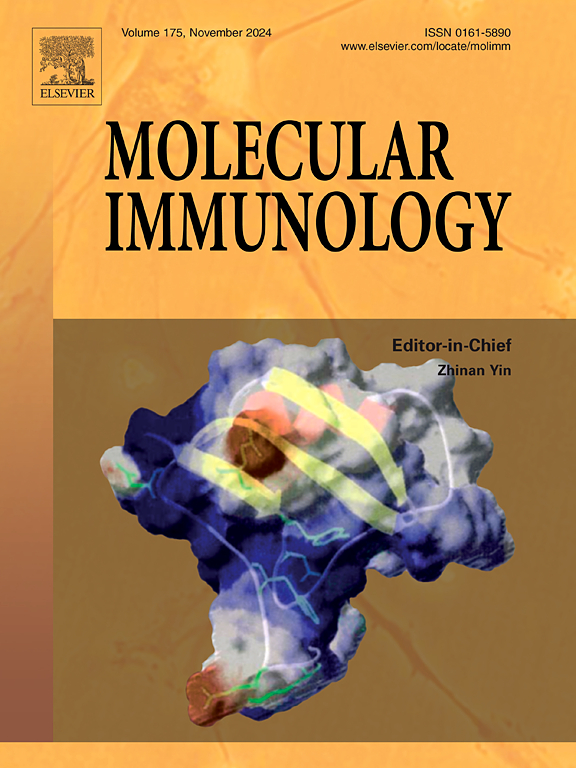Cold stimulated bronchial epithelial cells derived exosomes HMGB1 aggravates bronchial epithelial cells injury
IF 3
3区 医学
Q2 BIOCHEMISTRY & MOLECULAR BIOLOGY
引用次数: 0
Abstract
The aim of this study was to reveal the mechanism of cold stimulation (CS)-bronchial epithelial cells (BECs) derived exosomes (CS-BECs-exo) aggravated sepsis induced acute lung injury (SALI). CS-BECs-exo were separated by differential centrifugation and were characterized. Proteomics, immunoprecipitation, and RAGE knockout (RAGE) mice were used to investigate the mechanism of CS-BECs-exo aggravated SALI. The results of transmission electron microscope (TEM) showed that CS-BECs-exo showed a double-layer membrane structure like a saucer. Nanoparticle tracking analysis (NTA) particle size analysis showed that the average particle size of CS-BECs-exo was 123.6 nm. The results of proteomics showed that the expression level HMGB1 was significantly increased in CS-BECs-exo compared with BECs-exo. CS-BECs-exo significantly increased oxidative stress and inflammatory reaction of SALI. In addition, CS-BECs-exo significantly increased RAGE and decreased the levels of Nrf-2 and OH-1. RAGE knockout (RAGE KO) and silence of RAGE (RAGE siRNA) significantly canceled the effects of CS-BECs-exo on SALI. HMGB1 knockout (HMGB1) and silence of HMGB1 also significantly (HMGB1 siRNA) canceled the effects of CS-BECs-exo on SALI. In conclusion, CS-BECs-exo aggravated ALI in sepsis via HMGB1/RAGE/Nrf-2/OH-1 signal pathway.
冷刺激支气管上皮细胞衍生外泌体HMGB1加重支气管上皮细胞损伤。
本研究旨在揭示冷刺激(CS)-支气管上皮细胞(BECs)衍生外泌体(CS-BECs-exo)加重脓毒症诱导的急性肺损伤(SALI)的机制。CS-BECs-exo经差速离心分离并表征。采用蛋白质组学、免疫沉淀和RAGE敲除(RAGE)小鼠研究CS-BECs-exo加重SALI的机制。透射电镜(TEM)结果表明,CS-BECs-exo呈碟状双层膜结构。纳米颗粒跟踪分析(NTA)粒度分析表明,CS-BECs-exo的平均粒径为123.6 nm。蛋白质组学结果显示,与BECs-exo相比,CS-BECs-exo中HMGB1的表达水平显著升高。CS-BECs-exo显著增加SALI的氧化应激和炎症反应。此外,CS-BECs-exo显著增加RAGE,降低Nrf-2和OH-1水平。RAGE敲除(RAGE KO)和RAGE沉默(RAGE siRNA)显著抵消了CS-BECs-exo对SALI的作用。HMGB1敲除(HMGB1)和HMGB1沉默(HMGB1 siRNA)也显著抵消了CS-BECs-exo对SALI的影响。综上所述,CS-BECs-exo通过HMGB1/RAGE/Nrf-2/OH-1信号通路加重了脓毒症的ALI。
本文章由计算机程序翻译,如有差异,请以英文原文为准。
求助全文
约1分钟内获得全文
求助全文
来源期刊

Molecular immunology
医学-免疫学
CiteScore
6.90
自引率
2.80%
发文量
324
审稿时长
50 days
期刊介绍:
Molecular Immunology publishes original articles, reviews and commentaries on all areas of immunology, with a particular focus on description of cellular, biochemical or genetic mechanisms underlying immunological phenomena. Studies on all model organisms, from invertebrates to humans, are suitable. Examples include, but are not restricted to:
Infection, autoimmunity, transplantation, immunodeficiencies, inflammation and tumor immunology
Mechanisms of induction, regulation and termination of innate and adaptive immunity
Intercellular communication, cooperation and regulation
Intracellular mechanisms of immunity (endocytosis, protein trafficking, pathogen recognition, antigen presentation, etc)
Mechanisms of action of the cells and molecules of the immune system
Structural analysis
Development of the immune system
Comparative immunology and evolution of the immune system
"Omics" studies and bioinformatics
Vaccines, biotechnology and therapeutic manipulation of the immune system (therapeutic antibodies, cytokines, cellular therapies, etc)
Technical developments.
 求助内容:
求助内容: 应助结果提醒方式:
应助结果提醒方式:


